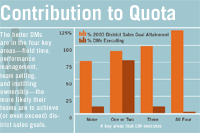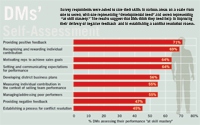Nobody Does it Better
Pharmaceutical Executive
If you work for a company that isn't interested in increasing sales across your portfolio, don't read this article. Otherwise, you'll learn that your district managers (DM) are the keys to doing just that. DMs select and hire new sales reps, guide product knowledge, develop selling skills, provide feedback, and take action to turn around or terminate poor performers. The average industry DM is responsible for generating tens of millions of dollars in sales through his or her teams. But, only 45 percent of industry DMs achieve their sales goals. Companies that succeed in raising the overall effectiveness of their DMs will create sustainable competitive advantage.
If you work for a company that isn't interested in increasing sales across your portfolio, don't read this article. Otherwise, you'll learn that your district managers (DM) are the keys to doing just that. DMs select and hire new sales reps, guide product knowledge, develop selling skills, provide feedback, and take action to turn around or terminate poor performers. The average industry DM is responsible for generating tens of millions of dollars in sales through his or her teams. But, only 45 percent of industry DMs achieve their sales goals. Companies that succeed in raising the overall effectiveness of their DMs will create sustainable competitive advantage.
Key Contributors
Health Strategies Group research with 819 district managers from 12 leading pharma companies identified four key areas that differentiate district managers who exceed their sales goals:
- Field Time
- Performance Management
- Team Selling
- Ownership
Practice makes perfect District managers influence sales skill development by observing calls and coaching the reps reporting to them. More field time translates into more opportunities to improve rep performance. Additionally, more field time spent coaching hones a DM's coaching skills and keeps those skills sharp. Field time also allows DMs to hear directly from customers, helping skilled listeners achieve an intimate understanding of their local markets.

Fish or cut bait Poorly performing reps drag down an entire district's sales performance, which should be reason enough for a DM to take decisive action. But in a world of overlapping territories and co-promotion arrangements, they also have a negative impact on the perceived performance of their territory counterparts. Over time, this can lead to dissention, disillusionment, and in the worst case, the loss of frustrated but good performers—with the poor performer remaining behind. By definition then, effective performance management includes swift action and resolution—through either improvement or departure.
United we stand In a complex environment where multiple reps often promote the same brands to the same customers, the successful district manager needs to lead individuals to function effectively as a team. In some cases reps do this on their own and the DM only needs to offer situational leadership such as consulting on joint territory plans. In other cases, reps have trouble working together and the DM role expands to include conflict resolution.
Own the business DMs need to help reps take ownership of territory sales performance. When done well, reps understand the link between their own behaviors and territory sales performance, and perceive that the DM's evaluation accurately reflects performance. When done poorly, reps do not buy in to their DM's assessment, and they feel less or even no ownership of their territory results. Experienced DMs know that reps have an easy time owning strong sales results. On the other hand, reps often resist taking ownership of poor results.
Seventy-eight percent of DMs surveyed execute well in one or two of the four key areas described previously. Ten percent say they execute none of the four. Most important, DMs who effectively execute in all four areas achieve superior sales results. (see "Contribution to Quota")

Contribution to Quota
Barriers to Effectiveness
Through company-provided training, intuition, or personal experience, effective DMs understand what tactics drive sales and can effectively implement them. Their approaches include conducting more two-day work sessions, providing broad coaching support outside of field days, and taking prompt and aggressive action on poor performers. Other DMs face three key challenges to implementing effective approaches:
- Administrative work cuts into field time.
- Mirrored geographies—in which multiple reps sell the same products to the same customers in the same zip codes—and co-promotion blur rep accountability for results.
- Underdeveloped coaching and performance management skills limit impact on rep development.
On average, DMs spend a quarter of their time conducting field visits, which they recognize is not enough. So what gets in the way? Time spent at company meetings, analyzing district business, responding to e-mail, completing required reports, recruiting, training, conference calls, travel, special projects, realignments, technology issues, preparation for district meetings, and so on. The most effective DMs find ways to minimize these challenges. They rapidly dispense with administrative requirements, quickly deduce business trends from key reports, conduct travel efficiently, and push back on field time conflicts. But other DMs need more help. (See "Where Are Your DMs?")

Where Are Your DMs?
External co-promotions and mirrored territories also create significant challenges for DMs, who may find themselves with multiple DM "partners" overlapping their district. Or, they may have one partner with reps, products, and target lists mirroring their own. In the first case, it quickly becomes impractical to engage with all partners, and in the second case, it becomes difficult to accurately assign credit (or blame) for business results. After all, accurate performance assessment drives ownership.
DMs recognize that developing reps begins with delivering feedback, and they struggle with this aspect of their job. Perhaps the easiest situation DMs encounter is when they observe reps performing well. But, only 71 percent of DMs believe they are highly skilled in providing positive feedback. If almost one-third of DMs are insecure about their ability to deliver positive feedback, then less comfortable settings are sure to present challenges. (See "DMs' Self-Assessment”)

DMs Self-Assessment
In fact, only 47 percent of DMs self-assess that they are proficient at providing negative feedback, and only 55 percent perceive that they "manage poor performers" well. Poor performers drain a DM's time and energy—and they deliver poor sales results. Consider a territory with a $6 million quota: 90 percent goal attainment (poor performance) costs $50,000 every month in lost sales. To resolve that problem, a DM needs to invest time in coaching and performance management, and potentially recruit, hire and train a replacement. Prompt and effective action on poor performers can mitigate the cost to the organization.
Regional Relief
Increasing DM effectiveness requires organizational commitment—sales training and management development, regional management, and senior sales management all contribute.
Sales training and management development DMs need help in developing reps. Fundamentals like delivering positive and negative feedback with equal ease and managing poor performers should form the core of training for new DMs.
Regional management Only one in seven regional managers (RM) regularly discusses coaching skills with their DMs—but it needs to be a priority. The discussion should focus on DMs'previous success (or lack of it) to change rep behavior.
The "STAR" framework (Situation-Task/Action-Result) can be useful. A typical dialogue between an RM and DM might look like this:
- Situation Let's talk about your coaching plan for one of your reps on pre-call planning. What led you to focus on that?
- Task/Action What specifically did you coach? What was the follow-up plan? What communication did you have with the rep about pre-call planning after the field day?
- Result Your next plan for this rep doesn't mention pre-call planning. Did you see changes in his pre-call planning? What were they? What are your next steps?
Senior sales management Senior leaders set the tone of the organization. And while there's no set number that defines the ideal resource allocation to sales operations for every company, appropriate budgeting helps to ensure that adequate training, tools, and resources are in place to guide DM's activity—toward spending more days in the field, creating and following up on developmental plans, and addressing performance problems aggressively. (See "HQ Support")

HQ Support
DMs struggle to balance administrative requirements with coaching time, so company leaders need to be aware of the many requests coming at them and push back to minimize their time spent on administration. When the organization needs information from the field, senior leaders must determine the extent of DM involvement required. Perhaps an administrative associate can collect the information, or it can be pulled from a database, or it can be bundled with other requests and handled more efficiently. Maybe the task shouldn't go forward at all. Even when tasks require DM time, they can be streamlined to present less of a field time barrier (a quick voice mail response versus a written report, spreadsheet, or web survey).
Every company experiences a bell curve of performance across positions, and district managers are no exception. How can companies capture the approaches of effective managers and transfer them to others? Education is an important first step, but simply knowing what to do is not the same as doing it. Sales trainers, regional managers, and senior sales managers can work together to equip DMs with the skills and resources necessary to implement effective practices. Organizations that do this well can expect more districts to consistently exceed sales goals.
Rick Rosenthal is a senior consultant and Rayna Herman is a principal at Health Strategies Group in Lambertville, New Jersey. They can be reached at rrosenthal@healthstrategies.com, and rherman@healthstrategies.com respectively.

The Misinformation Maze: Navigating Public Health in the Digital Age
March 11th 2025Jennifer Butler, chief commercial officer of Pleio, discusses misinformation's threat to public health, where patients are turning for trustworthy health information, the industry's pivot to peer-to-patient strategies to educate patients, and more.
Navigating Distrust: Pharma in the Age of Social Media
February 18th 2025Ian Baer, Founder and CEO of Sooth, discusses how the growing distrust in social media will impact industry marketing strategies and the relationships between pharmaceutical companies and the patients they aim to serve. He also explains dark social, how to combat misinformation, closing the trust gap, and more.